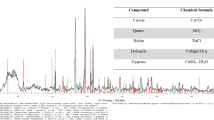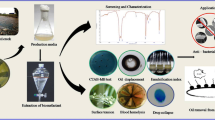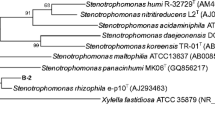Abstract
The capacities of a biosurfactant producing and polycyclic aromatic hydrocarbon (PAH) utilizing bacterium, namely, strain 1C, isolated from an Algerian contaminated soil, were investigated. Strain 1C belonged to the Paenibacillus genus and was closely related to the specie Paenibacillus popilliae, with 16S rRNA gene sequence similarity of 98.4 %. It was able to produce biosurfactant using olive oil as substrate. The biosurfactant production was shown by surface tension (32.6 mN/m) after 24 h of incubation at 45 °C and 150 rpm. The biosurfactant(s) retained its properties during exposure to elevated temperatures (70 °C), relatively high salinity (20 % NaCl), and a wide range of pH values (2–10). The infrared spectroscopy (FTIR) revealed that its chemical structure belonged to lipopeptide class. The critical micelle concentration (CMC) of this biosurfactant was about 0.5 g/l with 29.4 mN/m. In addition, the surface active compound(s) produced by strain 1C enhanced PAH solubility and showed a significant antimicrobial activity against pathogens. In addition to its biosurfactant production, strain 1C was shown to be able to utilize PAHs as the sole carbon and energy sources. Strain 1C as hydrocarbonoclastic bacteria and its interesting surface active agent may be used for cleaning the environments polluted with polyaromatic hydrocarbons.






Similar content being viewed by others
References
Abouseoud M, Maachi R, Amrane A, Boudergua S, Nabi A (2008a) Evaluation of different carbon and nitrogen sources in production of biosurfactant by Pseudomonas fluorescens. Desalination 223:143–151
Abouseoud M, Yataghene A, Amrane A, Maachi R (2008b) Biosurfactant production by free and alginate entrapped cells of Pseudomonas fluorescens. J Ind Microbiol Biotechnol 35:1303–1308
Al-Bahry SN, Al-Wahaibi YM, Elshafie AE, Al-Bemani AS, Joshi SJ, Al-Makhamari HS, Al-Sulaimani HS (2013) Biosurfactant production by Bacillus subtilis B20 using date molasses and its possible application in enhanced oil recovery. Int Biodeterior Biodegrad 81:141–146
Banat IM (1993) The isolation of a thermophilic biosurfactant producing Bacillus sp. Biotechnol Lett 15:591–594
Bezza FA, Evans M, Chirwa N (2015) Biosurfactant from Paenibacillus dendritiformis and its application in assisting polycyclic aromatic hydrocarbon (PAH) and motor oil sludge removal from contaminated soil and sand media. Process Saf Environ 98:354–364
Biria D, Maghsoudi E, Roostaazad R, Dadafarin H, Sahebghadam Lotfi A, Amoozegar MA (2010) Purification and characterization of a novel biosurfactant produced by Bacillus licheniformis MS3. World J Microbiol Biotechnol 26:871–878
Bradford MM (1976) A rapid and sensitive method for the quantification of microgram quantities of protein utilizing the principle of protein-dye binding. Anal Biochem 72:248–254
Cao XH, Liao ZY, Wang CL, Yang WY, Lu MF (2009) Evaluation of a lipopeptide biosurfactant from Bacillus natto TK-1 as a potential source of anti-adhesive, antimicrobial and antitumor activities. Braz J Microbiol 40:373–379
Chamkha M, Record E, Garcia JL, Asther M, Labat M (2002) Isolation from a shea cake digester of a tannin-tolerant Escherichia coli strain decarboxylating p-hydroxybenzoic and vanillic acids. Curr Microbiol 44:341–349
Chen YC, Chiang TJ, Liang TW, Wang I-L, Wang SL (2012) Reclamation of squid pen by Bacillus licheniformis TKU004 for the production of thermally stable and antimicrobial biosurfactant. Biocatal Agric Biotechnol 1:62–69
Cooper DG, Goldenberg BG (1987) Surface-active agents from two Bacillus species. Appl Environ Microbiol 53:224–229
Daane LL, Harjono I, Barns SM, Launen LA, Palleroni NJ, Haggblom MM (2002) PAH-degradation by Paenibacillus spp. and description of Paenibacillus naphthalenovorans sp. nov., a naphthalene-degrading bacterium from the rhizosphere of salt marsh plants. Int J Syst Evol Microbiol 52:131–139
Das K, Mukherjee AK (2005) Characterization of biochemical properties and biological activities of biosurfactants produced by Pseudomonas aeruginosa mucoid and non-mucoid strains isolated from hydrocarbon-contaminated soil samples. Appl Microbiol Biotechnol 69:192–199
Dubois M, Gilles KA, Hamilton JK, Rebers PA, Smith F (1956) Colorimetric method for determination of sugars and related substances. Anal Chem 28:350–356
Dutky SR (1940) Two new spore-forming bacteria causing milky diseases of Japanese beetle larvae. J Agric Res 61:57–68
Eddouaouda K, Mnif S, Badis A, Ben Younes S, Cherif S, Ferhat S, Mhiri M, Chamkha M, Sayadi S (2012) Characterization of a novel biosurfactant produced by Staphylococcus sp. strain 1E with potential application on hydrocarbon bioremediation. J Basic Microbiol 52:408–418
Felsenstein D, Carney WP, Iacoviello VR, Hirsch MS (1985) Phenotypic properties of atypical lymphocytes in cytomegalovirus-induced mononucleosis. J Infect Dis 152:198–203
Ferhat S, Mnif S, Badis A, Eddouaouda K, Alouaoui R, Boucherit A, Moulai-Mostefa N, Sayadi S (2011) Screening and preliminary characterization of powerful biosurfactants produced by two strains (Ochrobactrum sp. strain 1C and Brevibacterium sp. strain 7G) isolated from contaminated soils with petroleum hydrocarbons. Int Biodeterior Biodegrad 65:1182–1188
Gordon RE, Haynes WC, Pang CH (1973) The genus Bacillus. Agric. Handb. No 427 Wash. DC US Dep Agric
Gudiña EJ, Teixeira JA, Rodrigues LR (2010) Isolation and functional characterization of a biosurfactant produced by Lactobacillus paracasei. Colloids Surf B Biointerfaces 76:298–304
Gudiña EJ, Pereira JFB, Costa R, Evtuguin DV, Coutinho JAP, Teixeira JA, Rodrigues LR (2015) Novel bioemulsifier produced by a Paenibacillus strain isolated from crude oil. Microb Cell Fact 14:14. doi:10.1186/s12934-015-0197-5
Joo M-H, Kim J-Y (2013) Characteristics of crude oil biodegradation by biosurfactant-producing bacterium Bacillus subtilis JK-1. J Korean Soc Appl Biol Chem 56:193–200
Juhasz AL, Naida R (2000) Bioremediation of high molecular weight polycyclic aromatic hydrocarbons: a review of the microbial degradation of benzo[a]pyrene. Int Biodeterior Biodegrad 45:57–88
Jukes TH, Cantor CR (1969) Evolution of protein molecules. In: Munro HN (ed). N. Y. Acad. Press, p 21–132
Kiran GS, Thomas TA, Selvin J, Sabarathnam B, Lipton AP (2010) Optimization and characterization of a new lipopeptide biosurfactant produced by marine Brevibacterium aureum MSA13 in solid state culture. Bioresour Technol 101:2389–2396
Kumar M, Leon V, Manterano ADS, Ilzins OA, Luis L (2008) Biosurfactant production and hydrocarbon-degradation by halotolerant and thermotolerant Pseudomonas sp. World J Microbiol Biotechnol 24:1047–1057
Li J-L, Chen B-H (2009) Surfactant-mediated biodegradation of polycyclic aromatic hydrocarbons. Materials 2:76–94
Liang TW, Wu CC, Cheng WT, Chen YC, Wang CL, Wang IL, Wang SL (2014) Exopolysaccharides and antimicrobial biosurfactants produced by Paenibacillus macerans TKU029. Appl Biochem Biotechnol 172:933–950
Makkar RS, Cameotra SC (1997) Utilization of molasses for biosurfactant production by two Bacillus strains at thermophilic conditions. J Am Oil Chem Soc 74(7):887–889
Makkar RS, Rockne KL (2003) Comparison of synthetic surfactants and biosurfactants in enhancing biodegradation of polycyclic aromatic hydrocarbons. Environ Toxicol Chem 22:2280–2292
Mnif S, Chamkha M, Sayadi S (2009) Isolation and characterization of Halomonas sp. strain C2SS100 a hydrocarbon degrading bacterium under hypersaline conditions. J Appl Microbiol 107:785–794
Mnif S, Chamkha M, Labat M, Sayadi S (2011) Simultaneous hydrocarbon biodegradation and biosurfactant production by oilfield-selected bacteria. J Appl Microbiol 111(3):525–536
Najafi AR, Rahimpour MR, Jahanmiri AH, Roostaazad R, Arabian D, Soleimani M, Jamshidnejad Z (2011) Interactive optimization of biosurfactant production by Paenibacillus alvei ARN63 isolated from an Iranian oil well. Colloids Surf B Biointerfaces 82:33–39
NCCLS (National Committee for Clinical Laboratory Standards) (2002) Performance standards for antimicrobial susceptibility testing. Twelfth International Supplement, Wayne, PA, M100 (S12)
Nitschke M, Pastore GM (2006) Production and properties of a surfactant obtained from Bacillus subtilis grown on cassava wastewater. Bioresour Technol 97:336–341
Omotayo AE, Egbomeade LO, Taiwo O, Oyebamiji OO, Ilori MO (2013) Hydrocarbon degradation by free-living nitrogen-fixing bacteria. J Sci Res Dev 14:75–84
Pacwa-Płociniczak M, Płaza GA, Piotrowska-Seget Z, Cameotra SS (2011) Environmental applications of biosurfactants: recent advances. Int J Mol Sci 12(1):633–654
Pettersson B, Rippere KE, Yousten AA, Priest FG (1999) Transfer of Bacillus lentimorbus and Bacillus popilliae to the genus Paenibacillus with emended descriptions of Paenibacillus lentimorbus comb. nov. and Paenibacillus popilliae comb. nov. Int J Syst Bacteriol 49(Pt 2):531–540
Quinn GA, Maloy AP, McClean S, Carney B, Slater JW (2012) Lipopeptide biosurfactants from Paenibacillus polymyxa inhibit single and mixed species biofilms. Biofouling 28(10):1151–1166
Reddy MS, Naresh B, Leela T, Prashanthi M, Madhusudhan NC, Dhanasri G, Devi P (2010) Biodegradation of phenanthrene with biosurfactant production by a new strain of Brevibacillus sp. Bioresour Technol 101:7980–7983
Rippere KE, Tran MT, Yousten AA, Hilu KH, Klein MG (1998) Bacillus popilliae and Bacillus lentimorbus, bacteria causing milky disease in Japanese beetles and related scarab larvae. Int J Syst Bacteriol 48:395–402. doi:10.1099/00207713-48-2-395
Sadouk Z, Hacene H, Tazerouti A (2008) Biosurfactants production from low cost substrate and degradation of diesel oil by a Rhodococcus strain. Oil Gas Sci Technol–Rev IFP 63(6)
Saikia RR, Deka S, Deka M, Banat IM (2012) Isolation of biosurfactant-producing Pseudomonas aeruginosa RS29 from oil-contaminated soil and evaluation of different nitrogen sources in biosurfactant production. Ann Microbiol 62:753–763
Saimmai A, Rukadee O, Onlamool T, Sobhon V, Maneerat S (2012) Isolation and functional characterization of a biosurfactant produced by a new and promising strain of Oleomonas sagaranensis AT18. World J Microbiol Biotechnol 28:2973–2986
Saitou N, Nei M (1987) The neighbor-joining method: a new method for reconstructing phylogenetic trees. Mol Biol Evol 4:406–425
Samanta SK, Singh OV, Jain RK (2002) Polycyclic aromatic hydrocarbons: environmental pollution and bioremediation. Trends Biotechnol 20:243–248
Sharafi H, Abdoli M, Hajfarajollah H, Samie N, Alidoust L, Abbasi H, Fooladi J, Shahbani Zahiri H, Noghabi KA (2014) First report of a lipopeptide biosurfactant from thermophilic bacterium Aneurinibacillus thermoaerophilus MK01 newly isolated from municipal landfill site. Appl Biochem Biotechnol 173:1236–1249
Singh SN, Kumari B, Kumar Upadhyay S, Mishra S, Kumar D (2013) Bacterial degradation of pyrene in minimal salt medium mediated by catecholdioxygenases: enzyme purification and molecular size determination. Bioresour Technol 133:293–300
Suk WS, Lim HJ, Lee SJ (1999) Compositional analysis and some properties of biosurfactant from Pseudomonas sp. SW1. Korean J Appl Microbiol Biotechnol 27:41–45
Tamura K, Peterson D, Peterson N, Stecher G, Nei M, Kumar S (2011) MEGA5: molecular evolutionary genetics analysis using maximum likelihood, evolutionary distance, and maximum parsimony methods. Mol Biol Evol 28:2731–2739
Techaoei S, Lumyong S, Prathumpai W, Santiarwarn D, Leelapornoisid P (2011) Screening, characterization and stability of biosurfactant produced by Pseudomonas aeruginosa SCMU106 isolated from soil in Northern Thailand. Asian J Biol Sci 4:340–351
Weisburg WG, Barns SM, Pelletier DA, Lane DJ (1991) 16S ribosomal DNA amplification for phylogenetic study. J Bacteriol 173:697–703
Widdel F, Pfennig N (1981) Sporulation and further nutritional characteristics of Desulfotomaculum acetoxidans. Arch Microbiol 129:401–402
Winker S, Woese CR (1991) A definition of the domains Archaea, Bacteria and Eucarya in terms of small subunit ribosomal RNA characteristics. Syst Appl Microbiol 14:305–310
Yastrebova OV, Plotnikova EG, Anan’ina LN, Demakov VA (2009) Aerobic spore-forming bacteria from the region of salt mining. Russ J Ecol 40(7):516–521
Acknowledgments
This work was funded by the Algerian Ministry of Higher Education and Scientific Research by the CNEPRU project number J0100420120004. The authors would like to express their gratitude to Mr. Anouar Smaoui from the English Language Unit at the Faculty of Science of Sfax, Tunisia, for his valuable proofreading and language-polishing services. We express our thanks to Mr. Nidhal Bakkar and Mr. Hocine Boutoumi for their assistance in IR analyses and Mrs. Najla Mhiri and Mrs. Manel Chelbi for their help with molecular techniques.
Author information
Authors and Affiliations
Corresponding author
Additional information
Responsible editor: Robert Duran
Rights and permissions
About this article
Cite this article
Mesbaiah, F.Z., Eddouaouda, K., Badis, A. et al. Preliminary characterization of biosurfactant produced by a PAH-degrading Paenibacillus sp. under thermophilic conditions. Environ Sci Pollut Res 23, 14221–14230 (2016). https://doi.org/10.1007/s11356-016-6526-3
Received:
Accepted:
Published:
Issue Date:
DOI: https://doi.org/10.1007/s11356-016-6526-3




